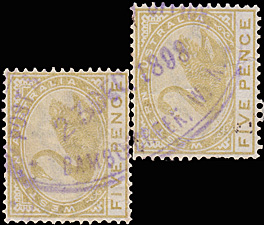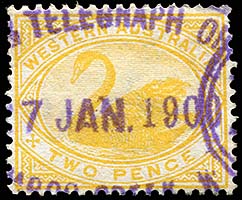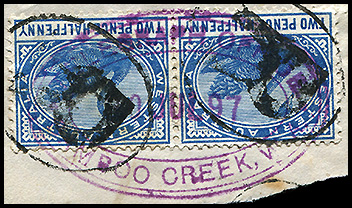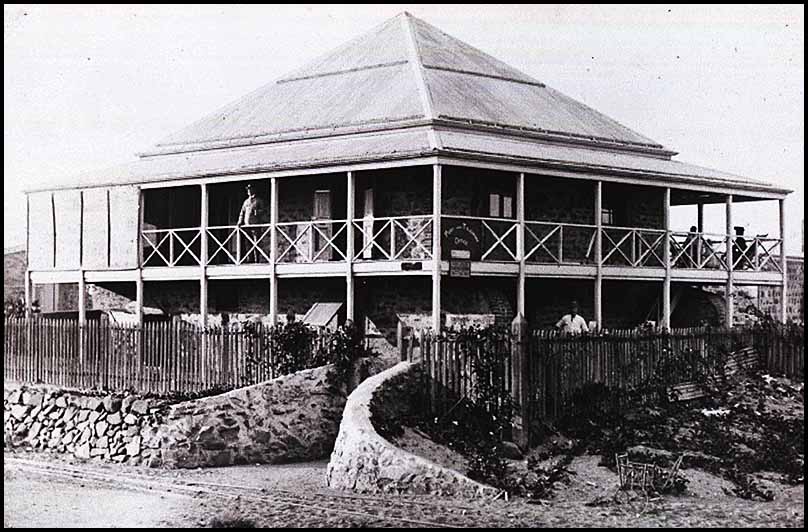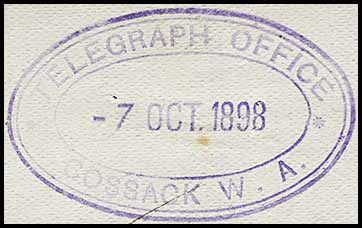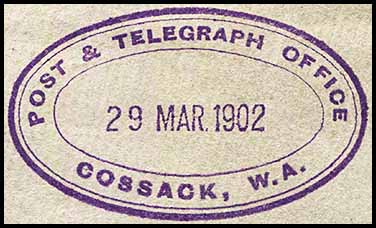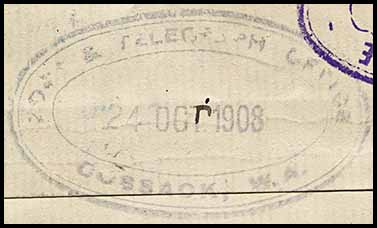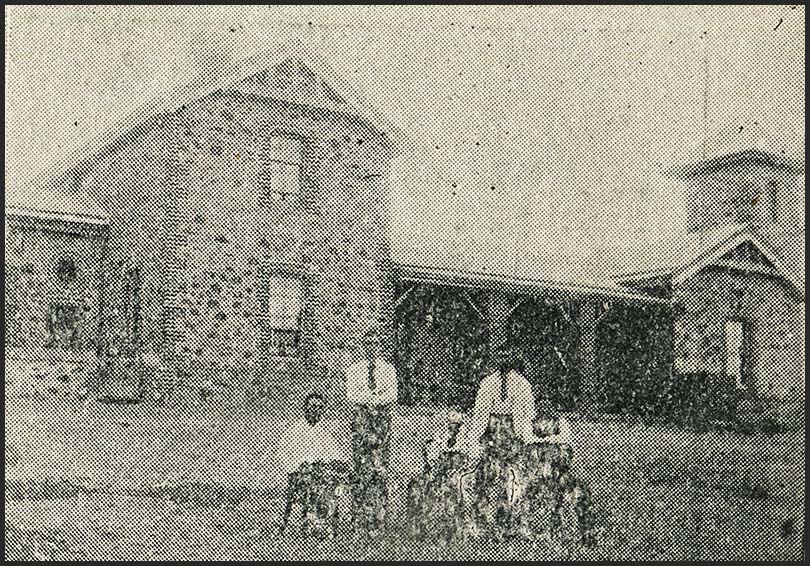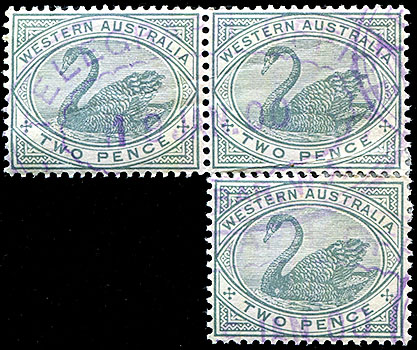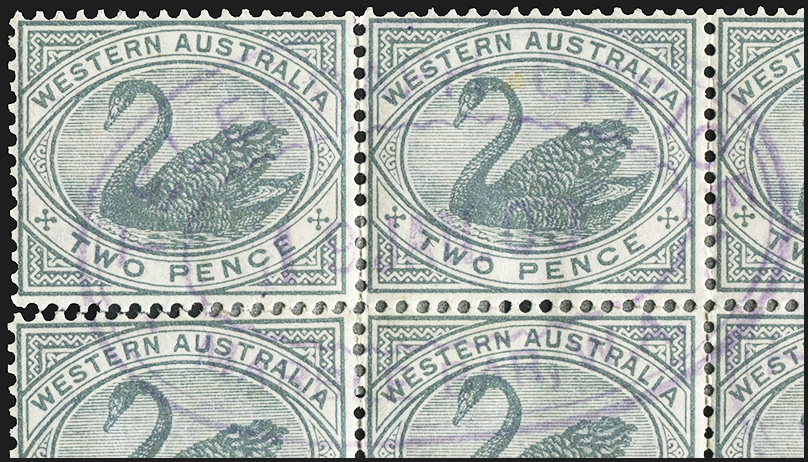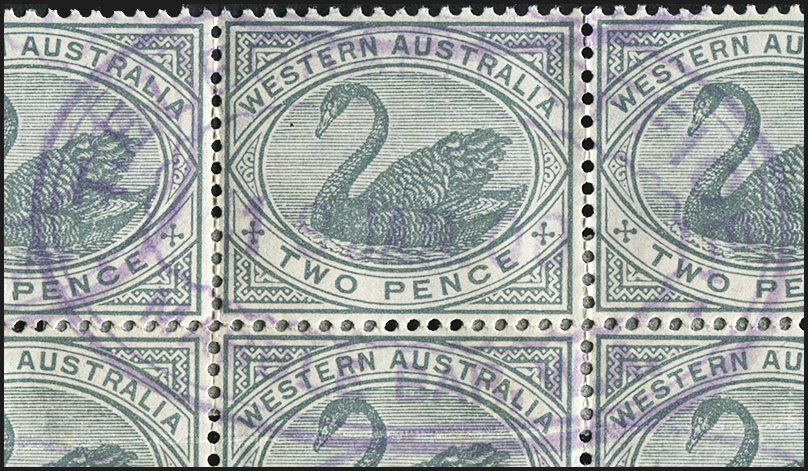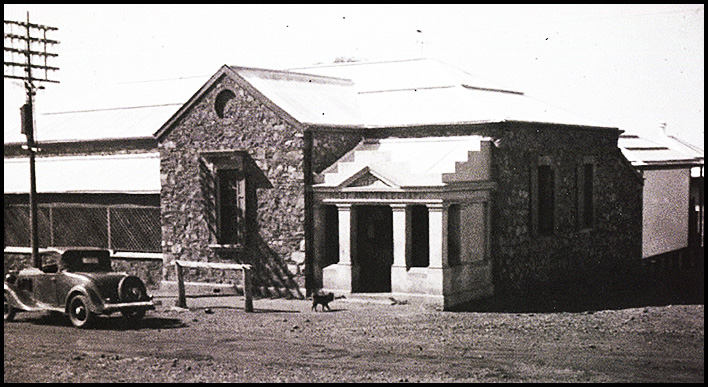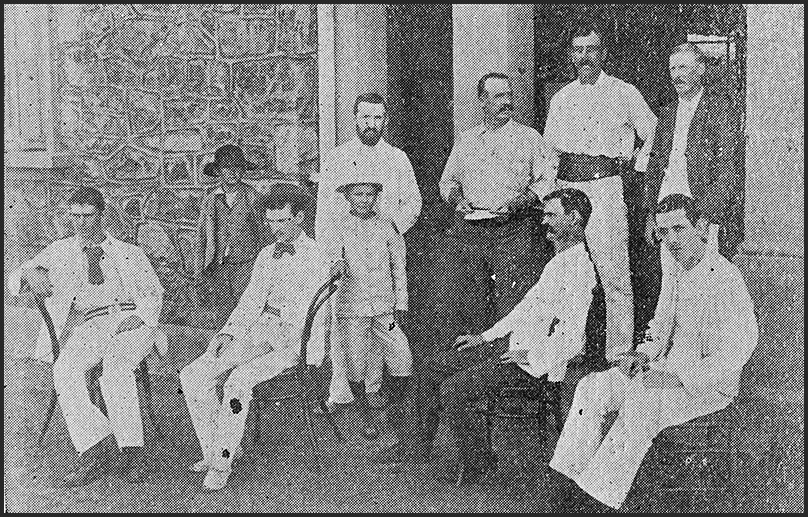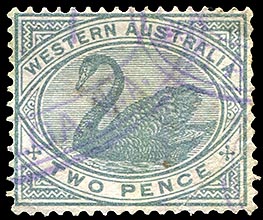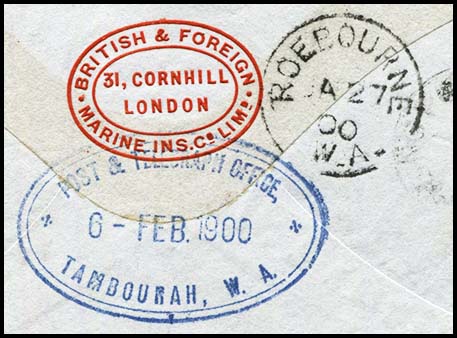Telegraph Offices in the Pilbara region.
- Australia 1901-1988
- New South Wales
- Overview of NSW
- Telegraph lines
- Telegraph Offices
- Date stamps
- Forms
- Envelopes
- Instructional annotation
- Collect
- Delayed
- Free
- Immediate Urgent
- Reply paid
- Rates
- Stamps
- 1871 Telegraph stamps
- 1885 proposal
- 1893 proposal
- Queensland
- South Australia
- Tasmania
- Victoria
- Western Australia
- International
- Special aspects
As most of the Telegraph Offices in the Pilbara were connected with the various gold finds, the following comment about the honest of those operating the telegraph network is of great relevance and open to questions as to fairness:
"Wages for miners are £4 a week, and there is a limited demand for men. The telegraph clerk, charged with every secret of importance and with a knowledge of transactions in which thousands of pounds are involved, vegetates in £100 or £120 per annum, which is a curious official way of inculcating that honesty is the best policy".
(Western Mail, 13 April 1895).
The following Telegraph Offices are included in this page:
| Ashburton | Balla Balla | Bamboo Creek | Boodarrie | ||
| Condon | Cossack | Fortescue | |||
| Mallina | Marble Bar | Newman | Nullagine | Onslow | Port Hedland |
| Roebourne | Talga | Tambourah | Tien Tsin | Warrawoona | Western Shaw |
|
Located on the coast about midway between Karatha and Port Hedland and about 20 km (13 miles) north of Whim Creek. There is no town there now - but there is Balla Balla Station (which would be known to happy campers and those who like to fish. A Post and Telegraph Office was opened on 21 October 1897 but it closed (probably) in 1903. About a year after the Office had opened, a cyclone hit the area and most of the buildings in the town - including the P&T Office were destroyed. In 1902 another storm hit the area damaging the port area and raising sea levels to about the level of the township. The area was, of course, very rich in minerals and especially gold. |
|
Boodarrie is just south-west of Port Hedland. Although there is now no township, Boodarrie Station is about 20 kms south-west of Port Hedland. The station is owned by BHP. A Telegraph Office was opened 17 August 1892 - during Tom Traine's time when he used Boodarrie as his base to ferry supplies to help establish business in Port Hedland. On 9 November 1897, the office was moved to Causeway Camp. That Telegraph Office was in turn was renamed Port Hedland in November 1898. No telegraph or postal marking is known from either of the first two offices. Personnel: 1892: Mr. C. J. Efford was transferred to be Lineman at Boodarrie haviing been Assistant and Lineman at Fortescue. |
|
The Port of Condon was established at the southern end of 80 mile Beach. Although there are several suggestions, the origins of its name are shrouded. By the 1860s, two homesteads were operating nearby:
The Port of Condon flourished from the mid-1860s because of the pearlers. When the pearling operations moved to Broome in the 1880s, the importance of the town began to decrease. When the mangroves were cleared from Port Hedland and that bay was developed into a Port, Condon quickly ebbed in size and importance. Before the demise of the Port however, the Condon Telegraph Office was opened on 9 April 1889. Unfortunately, as the population of Condon was less than 10, both the Telegraph Office and the Post Office were closed in 1927. Nevertheless, the locals had already organised their own entertainment and the Condon races were apparently well attended (relatively) when they could be held. The starting fields for the 21 June 1893 Race Meeting are provided elsewhere. The weights and other general information were published at the end of May while the results of all races were published in the Western Mail of 1 July. In June 1895, the Condon Telegraph Station was appointed as a polling place. Personnel: March 1890: Mr. A. Grosvenor was appointed Assistant Telegraph Station Master. |
||
A RO7-P&TO oval date stamp was issued to the Office. It is not recorded in Goulder.
|
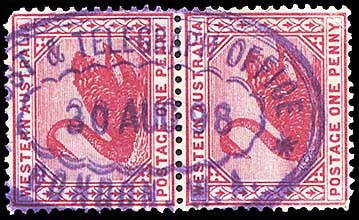 30 August 1898. Used on a pair of one penny carmine Swans (Crown over CA sideways watermark). |
|
No other special date stamp was issued to the Office for use with Telegraphs. Instead the usual postal date stamps would be used and these were in two formats:
|
||
|
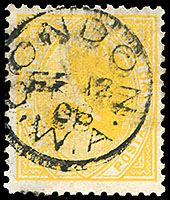 12 September 1908. |
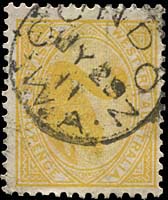 29 July 1911. |
|
The Telegraph Office is listed as opening on 17 November 1885 at 8:00 am. On 8 August 1884:
It merged to become a Post & Telegraph Office in 1904. On 10 September 1885, the vote for the Postal and Department was taken into consideration by the House and the following amendments were made after a discussion between the Colonial Secretary and the Postmaster-General: "... the salaries for the assistant telegraphist at the Fortescue £60 (a linesman was deemed to be unnecessary at Fortescue) and that of the native assistant £30 were struck out; the assistant telegraphist at the Ashburton was put down for £70 instead of £60". In January 1894, the annual dangerous weather struck the WA coast again. "The P. M. G. received a further telegram from Fortescue Station yesterday stating that the river again ran a banker on Wednesday night. It rose rapidly during the night, a tremendous body of water coming down, showing heavy rain inland. The telegraph operator was in a state of great anxiety, fearing the building wouId be washed away". Various newspapers (e.g. Bunbury Southern Times 16 February 1895) reported that the general Fortescue area was again struck with major rains in the first half of February 1895. Three telegraph poles and about 200 yards of wire washed away between Roebourne and Fortescue. The Perth Daily News (25 January 1895) reported that "heavy thunder storms occurred yesterday between Roebourne and Fortescue, and that at Lagrange Telegraph Station the lightening was so vivid the operator could not stop in the office last evening, having to keep his ground wire on". The building was designed to house the Meterological recording Office also. As a letter to the Editor of The Western Australian describes the building as being totally unsuitable for the Telegraph Station on the Fortescue River. In the Federal Election of March 1901, the Fortescue Telegraph Office was used as one of the Polling Places in the Swan Electorate. Personnel: 1885: Mr. J. J. Lawrence appears to have been the first Telegraph Officer (Station Master) at Fortescue. He had previously been at Eucla. He arrived at Bunbury on 17 October 1885 aboard the Franklin to spend time with friends before boarding the Otway to proceed north. 1892: Mr. E. J. Hackett, Telegraph Cadet, was appointed as Telegraph Assistant and Lineman at Fortescue; May 1894: Mr. E. A. Gratwick was appointed as Telegraph Master. | |
Although no date stamp was issued to Fortescue with "Telegraph" etc, two steel circular date stamps are known used during the Telegraph Office period (1885-1904):
|
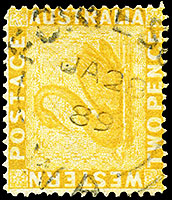 28 January 1889. |
|
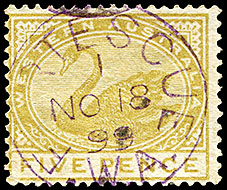 18 November 1899. |
|
Located about 20 km (13 miles) SE of Whim Creek. A Telegraph Office was opened there on 16 July 1896. It closed on 9 March 1899. |
| Marble Bar.
In June 1894, the Gazette reported that the tender to erect a Post and Telegraph Office at Marble Bar had been accepted from Wm. Britnall for £599 18s. On Saturday 25 August 1894, a temporary Telegraph Office opened at Marble Bar "under the management of Mr. Biederman". When the telegraph line to Marble Bar opened, one of the first messages sent to the Perth press indicated progress: "Broome has at last got a new gaol in which to confine malefactors." It was not as good a prison as Long Bay or Pentridge, for the first five native prisoners lodged in it escaped "in spite of every precaution". On 8 September 1894, the Nor'West Times printed the following (which is repeated as printed - despite the discomfort Mr. Biederman must have suffered): "The new Post and Telegraph Master arrived by the mail (sic) and, to the great delight of those obliged to send telegrams, normal rates now prevail. No-one grudged the contractors a fair additional charge for messages sent over their line from here to Condon, but it became too stiff when they charged double Melbourne and Sydney rates for prepaid wires to and from those places. The result naturally was that, those who had to send such telegrams, sent them by road to Condon whenever practicable. The material has arrived for the new Post and Telegraph office and the erection is proceeding as fast as could be expected considering skilled labour is not just now available". In describing Marble Bar in 1895, the West Australian said: "The township of Marble Bar, distant as I said, two and a half miles from the river, is bifurcated by a small creek which rigidly divides the goats from the sheep. I mean, not knowing which are the goats and which the sheep, the official from the non-official portions of the community. On the one side the police, the Warden and the Mining Registrar camp in primitive tents sheltered by spinifex. Temporarily the Telegraph and Postmaster and assistant live, and have their office, on the other side of the creek but their residence there among the oi polloi is but temporary and they will erelong rejoin the Brahmins of officialdom". Further trials and tribulations were encountered by the Marble Bar(bear)ians early in their Telegraph Office days: "The temporary Post and Telegraph Offices are delayed for want of screws and nails, which have been three times ordered, and have at last arrived at Cossack by the ill-fated Eddystone. The plans for the new offices — Warden's court, Registrar's and police quarters, cells and Post and Telegraph Offices, all under one roof - have arrived here at last and are of an elaborate description". |
|
|
|
Personnel: August 1894: Mr. R. Biederman was appointed the first Post and Telegraph Master at Marble Bar having been transferred from Narrogin. August 1894: R. J. Hardy was appointed as Telegraph Linesman at Marble Bar. August 1894: Mr. L. N. Lane was appointed as Assistant. June 1895: Mr. W. E. Edwrads was appointed Post and Telegraph Master. July 1896: "Owing to the great increase of business, the Telegraph Department (at Marble Bar) has found it necessary to reinforce the staff on this field by the appointment of two operators — Mr. Geo. Ackland, who was intended for Bamboo Creek but who, for the present, has taken charge of Talga Talga which office was re-opened at 7 p.m. on the 1st inst, having been closed from May 26, consequent on the secretary's illness — and Mr. E. C. Elliott for the Bar". (Northern Public Opinion, 25 July 1896). |
|
Only one rubber oval TELEGRAPH OFFICE date stamp (RO7 - TO) was issued to Marble Bar for use with telegraphs:
|
|
|
|
|
|
|
|
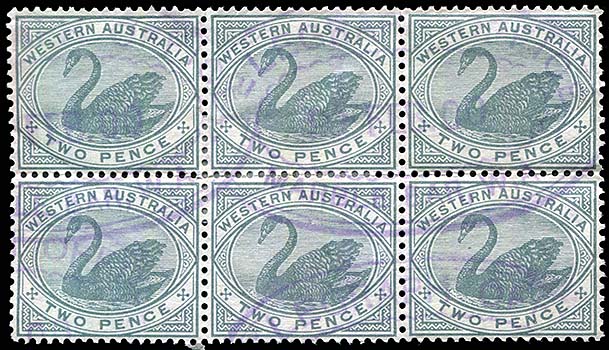 6 February 1900. |
|
A rubber oval Post Office/Marble Bar date stamp (RO6-PO) was issued to the Post Office for general use.
|
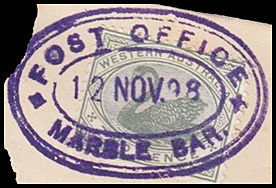 12 November 1898. |
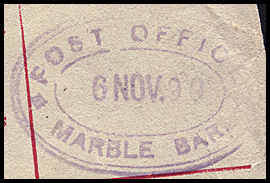 6 November 1899. Used on WC-DO-5A. |
| Usual postal date stamp sometimes used on telegrams. | ||
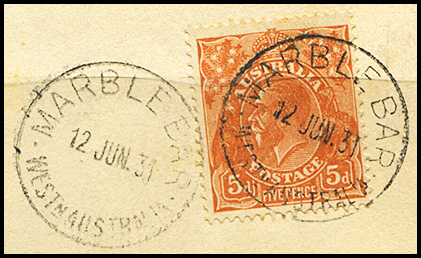 |
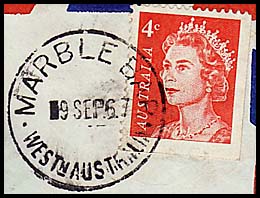 |
|
| Newman.
Newman is one of the main settlements in the Pilbara region. It was established by a BHP subsidiary in 1966. The privately owned Mount Newman Railway carried iron ore to Port Hedland. On 21 June 2001, a train 7.353 km (4.569 mi) long, comprising 682 ore cars and eight locomotives made the Newman—Port Hedland trip. It is listed as the world's longest ever train. The usual ore trains are over 2 km long. The Telegraph Office in Newman was a section of the Post Office which was opened on 1 February 1968. |
|
A rubber oval TELEGRAPH OFFICE date stamp (RO2-TO) was issued to Newman in the 1970s.
|
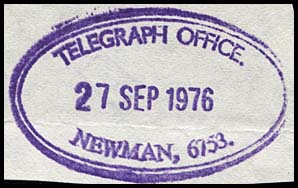 27 September 1976. |
|
The Telegraph Office at Nullagine opened on 8 February 1897. The name comes from an old aboriginal name Ngullagine which was a nearbu river. The meaning of the name has been lost. That spelling was common in the newspapers in the 1890s. It was "another isolated telegraph station. Nullagine was one of the golden camps of the early '90's and was described as having "gold all over the area". Personnel: January 1897: "Mr. C. McLarty, who has been a telegraph operator in the Roebourne office for nearly two years, left per the mail coach on Thursday for the Nullagine where be will act as Post and Telegraph Master. Mr. McLarty made many friends during his stay in Roebourne" |
||
| Two date stamps are recorded as having been issued to Nullagine for use with telegraphs. | ||
|
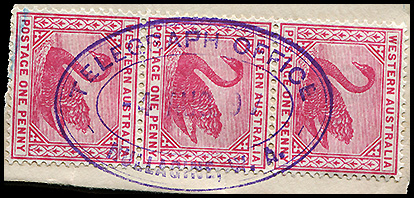 4 August 1897 (6 months after opening). |
|
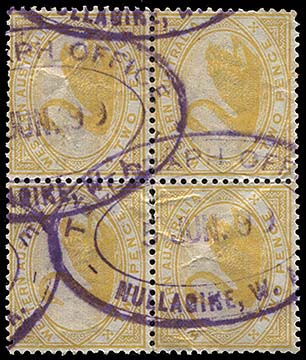 5 June 1899. |
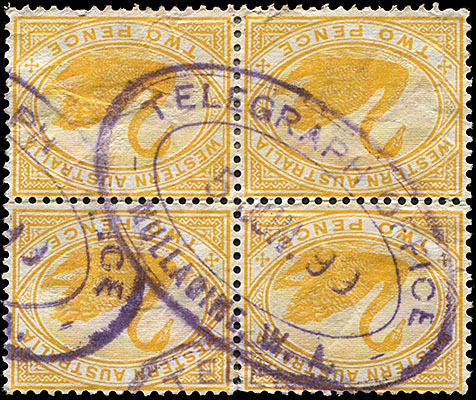 5 June 1899. Provemance: Pope. |
|
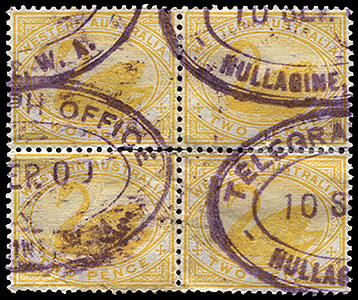 10 September 1900. A second block is also known - see Abacus Auctions, April 2019, Lot 1513. |
||
|
||
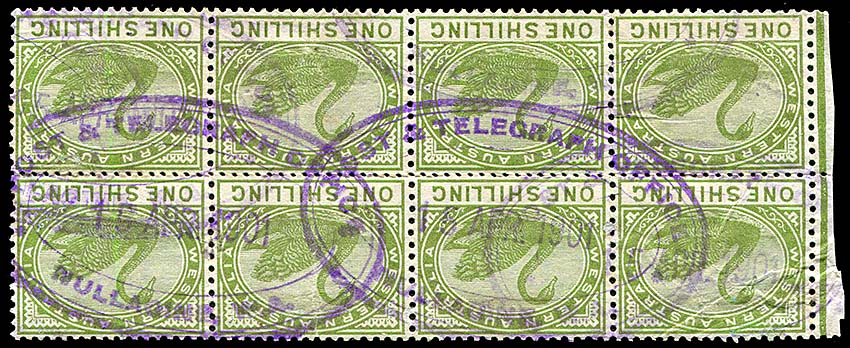 16 April 1901. |
||
|
A Post & Telegraph Office was opened in 26 October 1885 when Ashburton was renamed. A Post Office had been established at Ashburton on August 1884 and reclassified as a Post & Telegraph Office on 28 July 1885 after the telegraph line had been completed to that stage. The Office soon handled telegrams for places further north. The Daily Mail of 13 August 1885 "reminds our readers of the notice posted at the Telegraph Office to the effect that telegrams for Cossack and Roebourne, to be forwarded by horse-express from the Ashburton extension, will be received up till eight o'clock this (Thursday) evening". Soon after his appointment, Mr. Venn (Commissioner of Railways) made a 57 day tour around Australia inspecting facilities. At Oslow, he inspected the Government buildings: "Mr. Venn fixed on a suitable site for the new police quarters and decided that the telegraph qnarters were very unfit for residence and that it was necessary to have operators' quarters built" (Western Mail 27 August 1892). Onslow (submarine base) and Port Hedland were bombed by the Japanese forces during World War 2. It was also the service depot for the British atomic tests on Montebello Islands in the 1950s. Personnel: October 1885: Mr. J. Sinclair, Telegraph Station Master was transferred to Esperance to replace Mr. Carige. March 1895: Mr. W. E. Oliver, was transferred from Hall's Creek to be Operator in Charge of Onslow. The previous incumbent had been Mr. J. Murphy who was relieved by Mr. W. Rigg. Mr. Murphy then returned to Cossack. |
|
| Two formats of a rubber oval date stamp (RO6-TO) were issued to the Onslow Office.
Format 1: has large separation dots between upper and lower inscriptions below the level of the date.
|
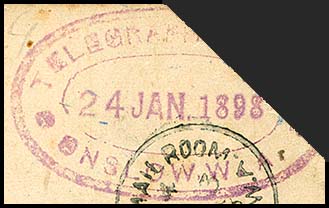 24 January 1898. Used on a post card to New Zealand. Has a very late used 15 bar '3' cancel. |
Format 2: has separation marks between the upper and lower inscriptions of two lines above the level of the date.
|
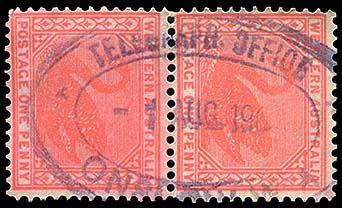 1 August 190?. |
| Port Hedland.
Port Hedland is one of the main settlements in the Pilbara region. The original Telegraph Office was opened about 10 miles (15 km) south east as Boodarie (Station) on 17 August 1892. The Gazette of 15 July 1892 noted Mr C. J. Efford had been appointed as a linesman at Boodarie. In July 1897, it was proposed that the telegraph station at Boodarie be removed to Port Hedland. That office was first moved to Causeway Bay on 9 November 1897 - possibly as a temporary measure. Tenders were invited by the Works Department for the construction of a Post and Telegraph Office at Port Hedland in June 1898. That tender for the Post and Telegraph Office at Port Hedland was accepted in July 1898. The combined office opened on 28 November 1898. The improvement was expected to be more convenient in view of the increasing importance of Port Hedland and the construction of a jetty at a cost of about £10,000. Port Hedland is now the base for FMG operations. Boodarie Station is owned by BHP. |
|
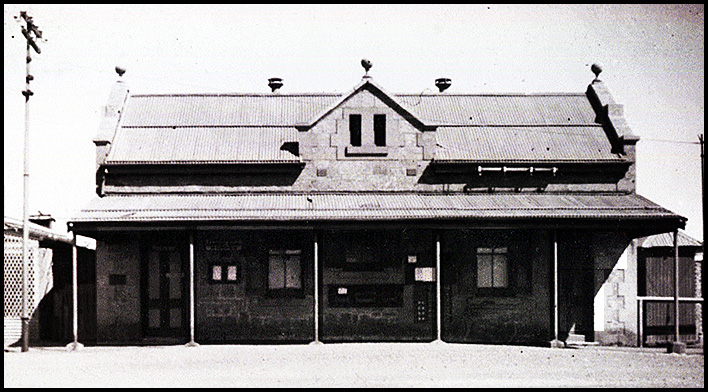 Port Hedland Post & Telegraph Office about 1940. |
|
Four date stamps have been recorded as having been issued to Port Hedland for use with telegraphs. The first two issued had the rare TELEGRAPH STATION inscription.
|
|
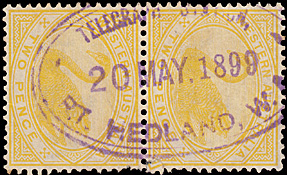 20 May 1899 (earliest recorded date). |
|
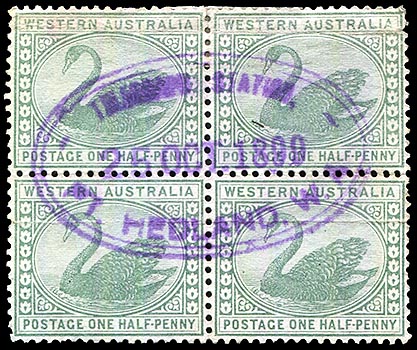 25 October 1899. |
|
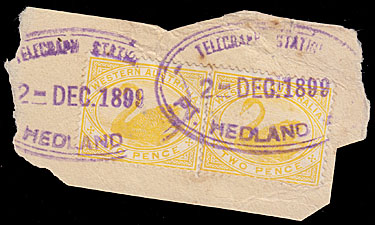 2 December 1899. |
|
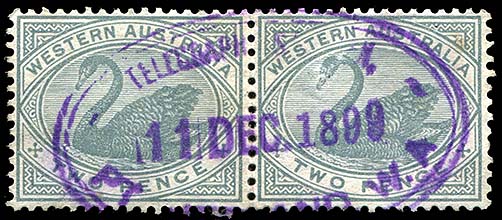 11 December 1899 (latest recorded date). |
|
|
|
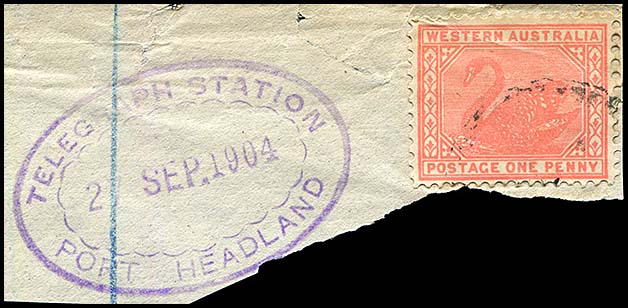 27 September 1904 - only known example. |
|
|
|
|
|
Postal date stamps were also used for telegraphic purposes. The date stamp at the right might be considered to have been used to pay transmission charges although that use is almost certainly impossible for telegrams as the 1893 Post and Telegraph act allowed revenue stamps and postal stamps to be interchangeable only to an amount of 1/-. |
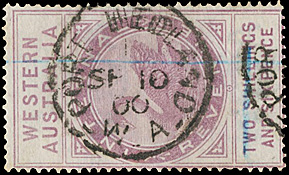 Port Hedland on 2/6 fiscal. 10 September 1900. Prestige Auctions, Sale 175, Lot 509. |
| Roebourne.
Roebourne was the first townsite in the Pilbara region to be gazetted - in 1866. The Post Office opened on 1 August 1878 and it was upgraded to a combined Post & Telegraph Office on 1 October 1885 - it appears in only temporary premises. The Western Australian of 27 October 1885 reported that "The line reached Roebourne on the 1st inst., and was opened for business the same day, under difficulties, as the operator had to send messages from under a verandah with the sun occasionally shining on him. He is now, however, working with the field instrument in a portion of the Post Office. No move has been made for the erection of a telegraph office". On 9 January 1886, the Western Mail noted the implications of the on-going problem with accommodation for the Roebourne Telegraph Office: "The Quarter Sessions will be held on the 6th January -I don't know where - as the room hitherto used for the purpose is now occupied by the telegraph department. There are, at present, four cases for trial - two for manslaughter, and two for larceny". But then - progress!! The Daily News of 11 February 1887 reported as follows: "We have seen the plans of the projected Roebourne Post and Telegraph Office and officers quarters, tenders for the erection of which have been invited by the Government. The building will evidently be both substantial in construction and attractive in appearance. It will be surrounded with a verandah eight feet in width, while precautions have been taken to ensure the roof being strongly battened down in sections, so as to withstand the force of any 'willy-willy' that may occur. In most places people experience a difficulty in raising the wind to get a roof over their heads; but Roebourne is a popular illustration to the contrary, as there the great trouble the inhabitants have to cope with is to keep the roofs from being raised by the wind". In August 1894, a Chess Club was formed in Roebourne. The Coolgardie Miner of 22 January 1896 reported that "Resentment against the Public Service Departments is not confined to the Southern fields. Complaint is made from Roebourne that mails arriving from Cossack by train are detained at the terminus - which is half a mile from the Post Office - owing to the fact that there is no contractor for the conveyance from the terminus to the Post Office but instead, the postal authorities depend upon the prison authorities for the use of the horse and cart - which is known as the water cart - and, at this time of the year, is always busily engaged conveying water to the Government employees. Hence it is not compulsory for the said cart to be in waiting. Recently the mails were detained at the terminus for one hour and twenty five minutes". On 26 January 1914, a Coastal Radio Wireless Station was established at Roebourne. |
||
|
||
Personnel: October 1885: Mr. E. G. Carige was appointed as Telegraph Station Master and Postmaster at Roebourne on his transfer from being Telegraph Station Master at Esperance Bay.
January 1891: Mr. W. Stewart (maybe W or J as his initial) was transferred as Linesman at Roebourne to be Linesman at Bunbury. February 1894: Mr. F. Charles Harvey, Telegraph Operator at Roebourne died of Marsh Fever or Influenza at age 23. March 1895: "The local post office is at present working short handed:
One assistant has gone to Bamboo Creek in view of telegraphic communication to that place being opened shortly. Another assistant left by the s. Albany to take charge of the station at Hall's Creek. Consequently only the postmaster and one assistant are left to do the work at Roebourne" (Daily News 4 April 1895). July 1895: A temporary alteration was made to the staff of the Roebourne telegraph office. Mr. S. Scott, assistant was transferred to the Fitzroy Station, West Kimberley, to relieve Mr. A. F. Cheek , Officer in Charge, and who assumed Mr. Scott's position at Roebourne. January 1897: "Mr. C. McLarty, who has been a telegraph operator in the Roebourne office for nearly two years, left per the mail coach on Thursday for the Nullagine, where he will act as Post and Telegraph master. Mr. McLarty made many friends during his stay in Roebourne" |
||
|
||
Date stamps. Two formats for date stamps issued to Roebourne for use with telegraphs may have been recorded: |
||
|
 5 October 1898. Earliest recorded date. |
|
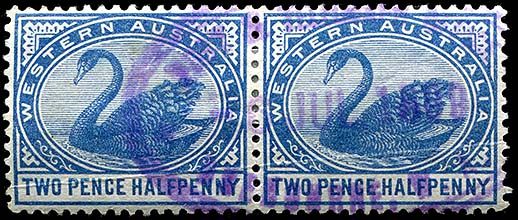 8 July 1899 . Second latest recorded date. |
||
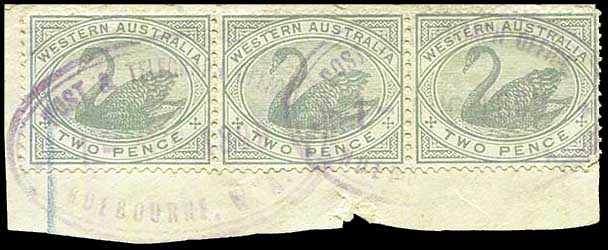 1 August 1899. Latest recorded date. |
||
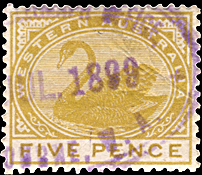 July 1899. |
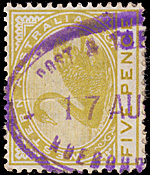 17 August ??. |
|
|
||
|
||
| The usual postal date stamp was also used at Roebourne especially in the early days of operation. |
Prestige Philately July 2009 Lot 633. |
|
|
Tambourah is south of Port Hedland. It replaced Talga Talga. The Telegraph Office was opened on 6 December 1897. It was, according to official records, reclassified as a Post & Telegraph Office on 1 July 1901 and was closed on 31 December 1903. The date stamps here show that it was a Post & Telegraph Office by 6 September 1899. |
||
A rubber oval date stamp (RO2 - P&TO):
|
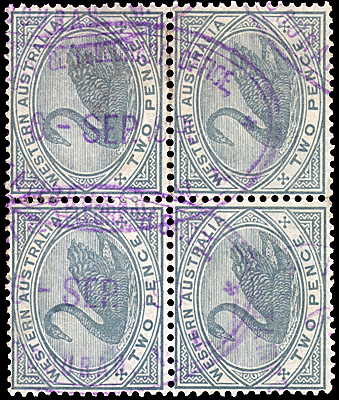 6 September 1899. |
|
|
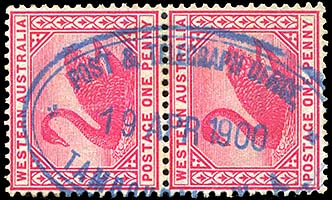 19 April 1900. |
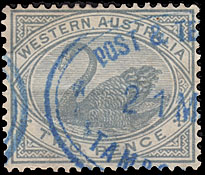 Incomplete date. |
6 February 1900. Complete strike in blue on reverse side of the cover shown below. |
||
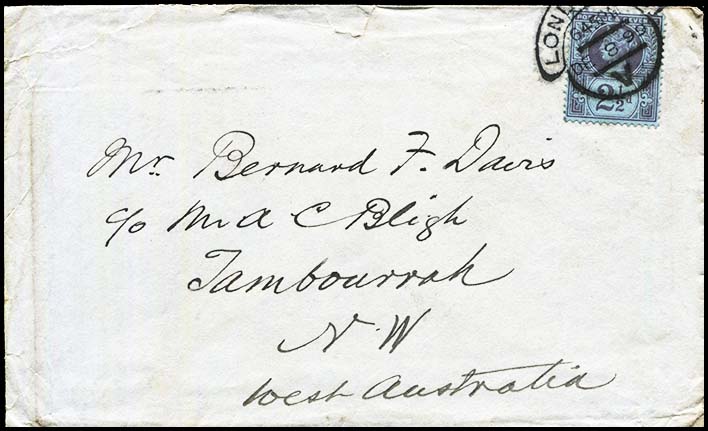 |
British & Foreign Marine Ins Co Limd envelope from London to "Tambourrah, NW, West Australia" on 8 December 1899. Has a 2½d violet/blue franking, and a 'ROEBOURNE/JA27/00/W.A' transit date stamp. The exceptionally fine Tambourah oval P&TO oval date stampm in ble is the only recorded comp;ete strike. Provenance: Cecil Walkley. |
|
|
Charles Kopeke (sometimes spelt Kopecke) is credited for discovering the gold reef in 1897 which ran for miles over the hills. He pegged a claim called Reward. Early reports described the whole region from Marble Bar to Nullagine as The Salgash Belt. Salgash is a long forgotten goldfield about 20 kilometres south south-east of Marble Bar. The general impression is that the initial gold discoveries made on and near the surface were incredibly rich, but they didn't extend at depth to any great extent. A Telegraph Office had opened at Salgash on 1 August 1898. It was renamed on 22 September 1898 after the inhabitants of Salgash insisted the town's name be changed to the indigenous Warrawoona. On 10 August 1902, the office was downgraded to an Allowance Office. |
|
Warrawoona is now the home of the Calidius Resources gold mining company. Calidius is an ASX listed company (CAI) with a market capitalisation (at the end of 2023) of about $125 million. |
|
| A rubber oval date stamp was issued to the P&T Office for use with telegram matters. | |
Used in violet: 23 September 1899. |
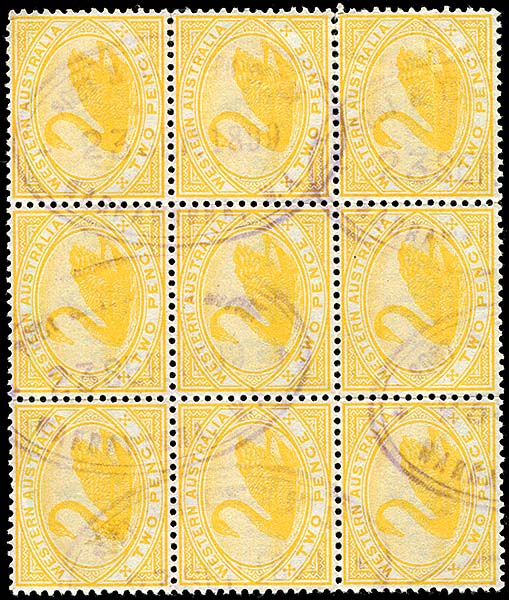 23 September 1899 - the only recorded example of commplete strikes. |
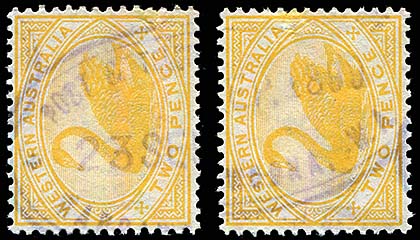 Two separate strikes of the date stamp - but possibly the same 23 September 1899 date. |
|
|
The Pilbara Goldfield News of 1 October 1897 reported :
In November 1897, £500 was allocated in the Estimates for the Telegraph Office and quarters. The Telegraph Office opened on 15 January 1898 - but closed after six months on 25 July 1898. Not surprising, no telegraph or post mark is known from the office. If only .... |
|
A copper mine began operation at Whim Creek in 1872. A Telegraph Office was opened on 15 October 1897. |
